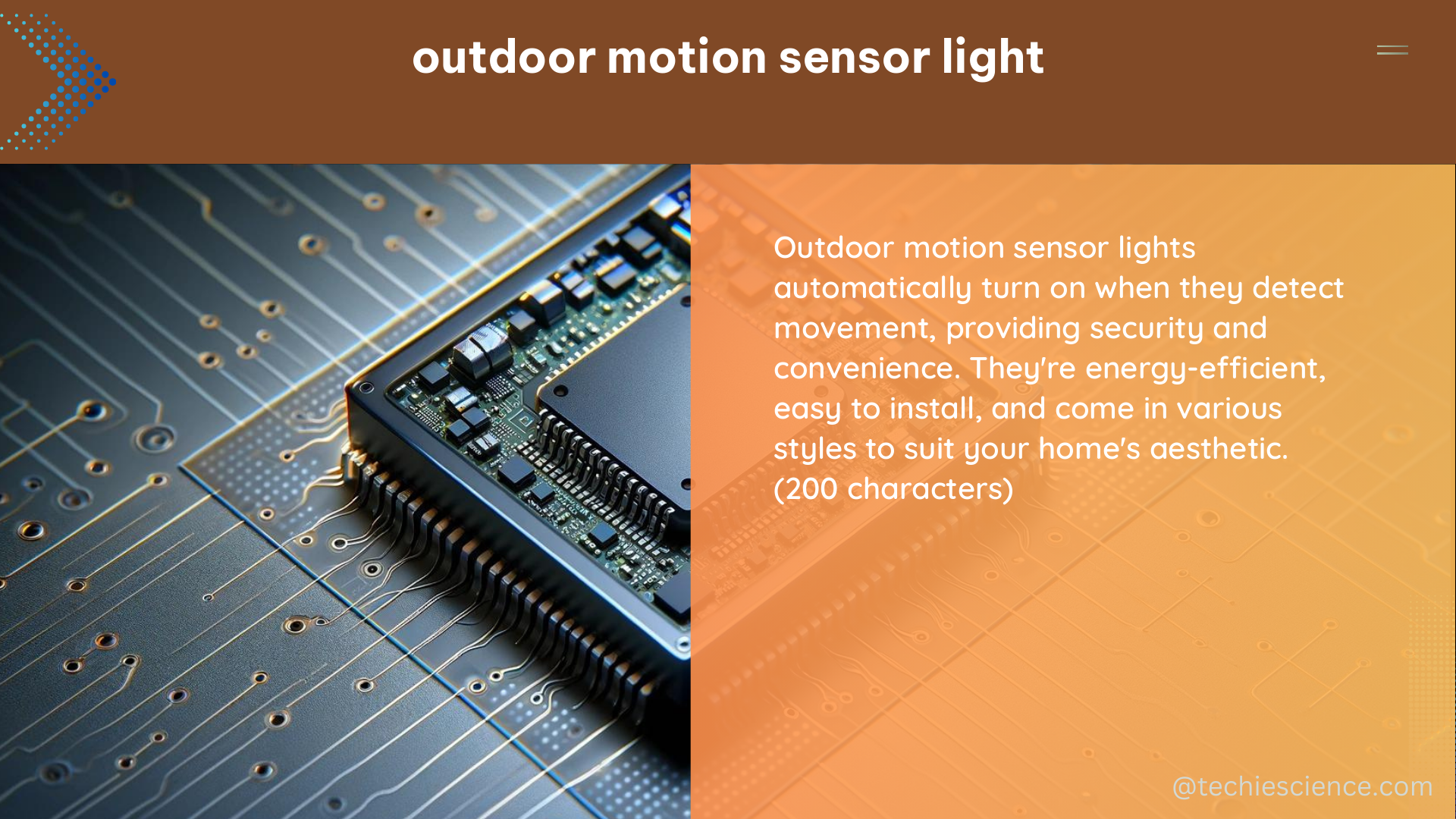Outdoor motion sensor lights are a popular choice for homeowners and businesses looking to enhance security, improve visibility, and conserve energy. These lighting fixtures use advanced motion detection technology to automatically illuminate when movement is detected, providing a convenient and efficient solution for outdoor lighting needs. In this comprehensive guide, we’ll explore the intricacies of outdoor motion sensor lights, addressing common challenges and providing practical solutions to help you make the most of these versatile lighting systems.
Understanding Motion Sensor Technology
Motion sensor lights rely on a variety of detection methods, including passive infrared (PIR), microwave, and dual-technology sensors. PIR sensors detect changes in infrared radiation caused by the movement of warm objects, such as people or animals, within their detection range. Microwave sensors use radio waves to detect motion, while dual-technology sensors combine PIR and microwave technologies for enhanced accuracy and reliability.
The detection range and coverage area of motion sensor lights can vary significantly, with typical ranges spanning from 30 to 80 feet and detection angles ranging from 180 to 360 degrees. Factors such as the sensor’s sensitivity, mounting height, and the surrounding environment can all impact the effectiveness of the motion detection system.
Overcoming Challenges in Outdoor Environments

Outdoor motion sensor lights face unique challenges due to the harsh environmental conditions they are exposed to. These include:
-
Weather Resistance: Outdoor motion sensor lights must be designed to withstand the elements, including rain, snow, humidity, and temperature fluctuations. Waterproof enclosures, corrosion-resistant materials, and robust sealing mechanisms are essential for ensuring long-term reliability and performance.
-
Detection Accuracy: The irregular terrain and varying obstructions found in outdoor settings can compromise the motion sensor’s ability to accurately detect movement. Strategically positioning multiple motion sensor lights or incorporating supplementary lighting sources can help overcome these challenges and provide comprehensive coverage.
-
Energy Efficiency: Outdoor motion sensor lights should be designed with energy efficiency in mind, utilizing LED technology and advanced control systems to minimize power consumption and reduce operating costs. Integrating these lights with smart home platforms or incorporating solar power options can further enhance their energy-saving capabilities.
Compatibility and Integration
Integrating outdoor motion sensor lights with existing lighting, security, or smart home systems can present compatibility challenges. Ensuring seamless integration requires addressing various communication protocols, control interfaces, and proprietary technologies used by different manufacturers.
To overcome these obstacles, look for motion sensor lights that offer compatibility with popular smart home platforms, such as Amazon Alexa, Google Assistant, or Apple HomeKit. Additionally, consider motion sensor lights that support industry-standard communication protocols, such as Wi-Fi, Bluetooth, or Z-Wave, to facilitate easy integration and remote control capabilities.
DIY Modifications and Customization
For DIY enthusiasts, there are several options for bypassing or customizing the motion detection functionality of outdoor flood lights. These include:
-
Bypassing the Motion Detector: A simple jumper can be added to bypass the motion detector, allowing the light to remain on continuously. This approach is suitable for situations where the motion sensor is not required or is causing unwanted activation.
-
Direct LED Connection: In some cases, the +12V can be directly connected to the LED+ terminal, effectively disabling the motion sensor and keeping the light on at all times.
-
Pulse Width Modulation (PWM) Adjustment: Modifying the PWM output of the motion sensor can help fine-tune the light’s behavior, such as adjusting the duration or sensitivity of the motion detection.
When undertaking any DIY modifications, it’s crucial to exercise caution and follow safety protocols to avoid potential electrical issues or complications.
Conclusion
Outdoor motion sensor lights offer a versatile and efficient solution for enhancing security, improving visibility, and conserving energy in outdoor environments. By understanding the underlying technology, addressing the unique challenges of outdoor settings, and exploring integration and customization options, you can maximize the benefits of these lighting systems and create a safer, more energy-efficient outdoor space.
References:
– Overriding the motion sensor on a outside light – Mike Holt’s Forum, 2007-04-23, https://forums.mikeholt.com/threads/overriding-the-motion-sensor-on-a-outside-light.35035/
– Motion Sensor Lights Market Size, Forecast, 2023-2031, Verified Market Research, https://www.verifiedmarketresearch.com/product/motion-sensor-lights-market/
– How Light Sensors Work, enDAQ Blog, https://blog.endaq.com/how-light-sensors-work
– How to solve the dilemma of motion activated lights, r/homeassistant, 2022-09-30, https://www.reddit.com/r/homeassistant/comments/xrt67g/how_to_solve_the_dilemma_of_motion_activated/
– How to bypass motion detector on outdoor flood light, DIY Stack Exchange, 2022-11-15, https://diy.stackexchange.com/questions/260526/how-to-bypass-motion-detector-on-outdoor-flood-light

The lambdageeks.com Core SME Team is a group of experienced subject matter experts from diverse scientific and technical fields including Physics, Chemistry, Technology,Electronics & Electrical Engineering, Automotive, Mechanical Engineering. Our team collaborates to create high-quality, well-researched articles on a wide range of science and technology topics for the lambdageeks.com website.
All Our Senior SME are having more than 7 Years of experience in the respective fields . They are either Working Industry Professionals or assocaited With different Universities. Refer Our Authors Page to get to know About our Core SMEs.